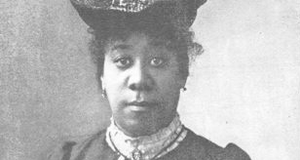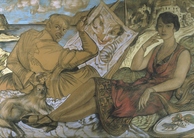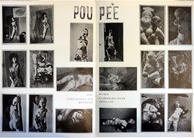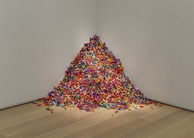The Medicalization of Blackness: Rashid Johnson and the Diseased Connotations of Race
By
2015, Vol. 7 No. 04 | pg. 2/2 | « Without prior knowledge of its symbolic value, it would be discounted as meaningless or illegible. This exploration of new ways to communicate utilizes the attributes of Aphro-futurism in imagining a codified language shared by those who are black, as well as calling upon a fictional secret society of African-American intellectuals.8 The use of these mysterious signs, including the symbolic use of West African soap, perhaps promises a full experience only to viewers who have, like the artist, insider knowledge on symbolism held prominent in African-American culture. Meanwhile, it excludes those populations that may have historically been exclusionary according to race and ethnicity, which gives new meaning to the idiom “giving them a taste of their own medicine.” Furthermore, the spontaneous, graffiti-like aesthetics uphold the Sigma Pi Phi (referred to as Boulé) as trustworthy while suggesting a skeptical view of “official” higher authority such as medical and government professionals. These feelings of neglect and distrust recall the implicit intention of American legal doctrine to oppress African-Americans, such as the Jim Crow Laws (1800-1866). Antibiotic thus implicates the American government, a public entity entrusted with preserving peace and safety of its citizens, in passively allowing the disenfranchisement and marginalization of African-American communities. This desperate signal to Sigma Pi Phi as an all male, all African-American brotherhood envisions a future for African-Americans with complete personal autonomy, offering a hopeful alternative for the failures of the current political system. This draws striking parallels to One Year of AZT (1991), a work by General Idea that criticized the governmental response to AIDS. Within this work, General Idea explores the virus as both an undesired identity and model for ideological struggle. AZT, the pill administered to HIV-positive patients to delay the onset of AIDS, is repeated in enlarged forms, mocking the efficient look of pharmaceutical packaging. Working within an era when the majority of HIV and AIDS patients where homosexual, and thus its stigmatization as a “gay disease,” the work seeks to question the authority of higher powers while deconstructing homophobia.9 For although AZT was proven successful in delaying death from AIDS, it was highly toxic and did not offer a cure; thus, each repeated pill represents a hopeless countdown until death.10 What General Idea and Rashid Johnson similarly confront is the prejudices existing even in presumed unbiased sciences, the reluctance of society to sympathize with marginalized populations. Their works also look at the construction of myth, and how marginalized populations, whether it be homosexuals or African-Americans, become viewed by the public as intrinsic bearers of disease. Although they are often assumed to be objective, statistics can ultimately manipulated to serve personal interests; during the 1990s, for example, excessive arrest and imprisonment rates of African-Americans were used as indisputable proof of their inferiority and social incompetency.11 Similar to General Idea’s critique of heteronormative thinking in the initial branding of AIDS as the “gay plague,” what Johnson critiques is the association of blackness with social deviance that warrants treatment. The title Antibiotic critiques the process in society by which those who deviate from the norm are expected to have their behavior corrected. In the book The Medicalization of Society: On Transformations of the Human Conditions into Treatable Disorders, Peter Conrad discusses illness as societal constructions, describing the recently identified phenomenon of medicalization as “a process by which nonmedical problems become defined and treated as medical problems, usually in terms of illness and disorders.”12 Within the past century, the number of named medical disorders has drastically increased, with each condition having a corresponding chemical treatment; what Johnson captures in Antibiotic is a concern similar to Conrad’s, which is that medicalization has become more or less a disguised form of social control. Johnson recognizes that the power of social control lies in those with the authority to define the abnormal and warns against homogeneity. His depiction of a monolithic black abyss is an abysmal prediction of the gradual sanitization of culture. Antibiotic is essentially a foreboding warning, rendering inhumane and unjust the historical treatment of the subaltern. Ultimately, in his search for a strictly autobiographical read of his artwork, perhaps what Johnson desired was to be recognized as an individual unburdened by a grander history. His pursuit of a black identity that exists outside of a discussion on racism has gone insofar as to be labeled as a “post-black” artist.13 In truth, Johnson’s explorations of dissociating the color black with negative connotations simultaneously calls for discarding black from associations with race altogether. Antibiotic effectively problematizes the fact that an entire identity is subsumed under one color, asserting the detriments of blackness as an abstraction of cultural stereotypes for African-Americans. Johnson’s work moves towards more nuanced notions of African-American identity that calls for transcending skin color, calling for a realization of black as a color rather than a singular definition of identity. ReferencesBordowitz, Gregg. General Idea: Imagevirus. Afterall Publishing, 2010. Bowles, John P. Adrian Piper: Race, Gender, and Embodiment. Duke University Press, 2011. Conrad, Peter. The Medicalization of Society: On the Transformation of Human Conditions into Treatable Disorders. JHU Press, 2008. Fee, Elizabeth, and Daniel M. Fox. AIDS: The Making of a Chronic Disease. University of California Press, 1992. Gellner, Uwe. Rashid Johnson: Sharpening My Oyster Knife. Bielefeld, Germany: Kerber Verlag, 2009. Golden, Thelma, Christine Y Kim, Hamza Walker, Franklin Sirmans, and Studio Museum in Harlem. Freestyle. New York, NY: Studio Museum in Harlem, 2001. Hicks, Cinqué. “What Is Afrofuturist Art?” San Francisco, CA: Patricia Sweetow Gallery, 2004. Julie Rodrigues Widholm. “Rashid Johnson: Message to Our Folks.” In The Moment of Creation. Belgium: Die Keure Press, 2012. Levy, Peter B. “Dream Deferred: The Assassination of Martin Luther King, Jr., and the Holy Week Uprisings of 1968.” In Baltimore ’68 : Riots and Rebirth in an American City. Philadelphia: Temple University Press, 2011. Muhammad, Khalil Gibran. The Condemnation of Blackness: Race, Crime, and the Making of Modern Urban America. Cambridge, Mass.: Harvard University Press, 2010. Rashid Johnson Makes Things to Put Things On. New York Close Up. Art21, Last modified 2011. http://www.art21.org/newyorkcloseup/films/rashid-johnson-makes-things-to-put-things-on/. Reed, Rodney J. “History of the Boulé.” Sigma Pi Phi Fraternity, n.d. Accessed November 21, 2013. Endnotes
Suggested Reading from Inquiries Journal
Inquiries Journal provides undergraduate and graduate students around the world a platform for the wide dissemination of academic work over a range of core disciplines. Representing the work of students from hundreds of institutions around the globe, Inquiries Journal's large database of academic articles is completely free. Learn more | Blog | Submit Latest in Visual Arts |



















